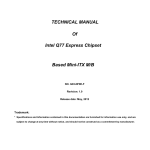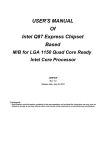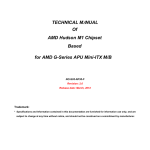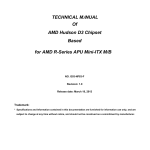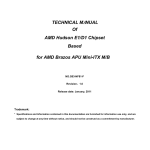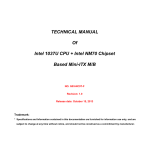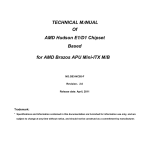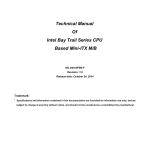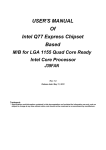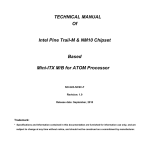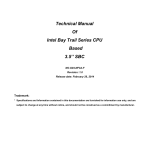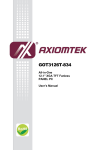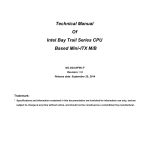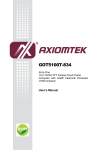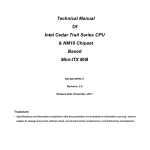Download NF9G-QM77 User`s Manual
Transcript
TECHNICAL MANUAL Of Intel QM77 Express Chipset Based Mini-ITX M/B NO. G03-NF9G-F Revision: 1.0 Release date: August 28, 2012 Trademark: * Specifications and Information contained in this documentation are furnished for information use only, and are subject to change at any time without notice, and should not be construed as a commitment by manufacturer. Environmental Protection Announcement Do not dispose this electronic device into the trash while discarding. To minimize pollution and ensure environment protection of mother earth, please recycle. i TABLE OF CONTENT ENVIRONMENTAL SAFETY INSTRUCTION........................................................................... iii USER’S NOTICE ....................................................................................................................... iv MANUAL REVISION INFORMATION ....................................................................................... iv ITEM CHECKLIST ..................................................................................................................... iv CHAPTER 1 INTRODUCTION OF THE MOTHERBOARD 1-1 FEATURE OF MOTHERBOARD................................................................................ 1 1-2 SPECIFICATION ......................................................................................................... 2 1-3 LAYOUT DIAGRAM.................................................................................................... 3 CHAPTER 2 HARDWARE INSTALLATION 2-1 JUMPER SETTING ..................................................................................................... 8 2-2 CONNECTORS AND HEADERS................................................................................ 12 2-2-1 CONNECTORS ............................................................................................. 12 2-2-2 HEADERS ..................................................................................................... 15 CHAPTER 3 INTRODUCING BIOS 3-1 ENTERING SETUP ..................................................................................................... 24 3-2 BIOS MENU SCREEN ................................................................................................ 25 3-3 FUNCTION KEYS ....................................................................................................... 25 3-4 GETTING HELP .......................................................................................................... 26 3-5 MAIN BARS................................................................................................................. 26 3-6 MAIN MENU ................................................................................................................ 27 3-7 ADVANCED MENU..................................................................................................... 28 3-8 CHIPSET MENU.......................................................................................................... 35 3-9 BOOT MENU ............................................................................................................... 39 3-10 SECURITY MENU ....................................................................................................... 41 3-11 SAVE & EXIT MENU................................................................................................... 42 ii Environmental Safety Instruction z Avoid the dusty, humidity and temperature extremes. Do not place the product in any area where it may become wet. z 0 to 60 centigrade is the suitable temperature. (The figure comes from the request of the main chipset) z Generally speaking, dramatic changes in temperature may lead to contact malfunction and crackles due to constant thermal expansion and contraction from the welding spots’ that connect components and PCB. Computer should go through an adaptive phase before it boots when it is moved from a cold environment to a warmer one to avoid condensation phenomenon. These water drops attached on PCB or the surface of the components can bring about phenomena as minor as computer instability resulted from corrosion and oxidation from components and PCB or as major as short circuit that can burn the components. Suggest starting the computer until the temperature goes up. z The increasing temperature of the capacitor may decrease the life of computer. Using the close case may decrease the life of other device because the higher temperature in the inner of the case. z Attention to the heat sink when you over-clocking. The higher temperature may decrease the life of the device and burned the capacitor. iii USER’S NOTICE COPYRIGHT OF THIS MANUAL BELONGS TO THE MANUFACTURER. NO PART OF THIS MANUAL, INCLUDING THE PRODUCTS AND SOFTWARE DESCRIBED IN IT MAY BE REPRODUCED, TRANSMITTED OR TRANSLATED INTO ANY LANGUAGE IN ANY FORM OR BY ANY MEANS WITHOUT WRITTEN PERMISSION OF THE MANUFACTURER. THIS MANUAL CONTAINS ALL INFORMATION REQUIRED TO USE THIS MOTHER-BOARD SERIES AND WE DO ASSURE THIS MANUAL MEETS USER’S REQUIREMENT BUT WILL CHANGE, CORRECT ANY TIME WITHOUT NOTICE. MANUFACTURER PROVIDES THIS MANUAL “AS IS” WITHOUT WARRANTY OF ANY KIND, AND WILL NOT BE LIABLE FOR ANY INDIRECT, SPECIAL, INCIDENTAL OR CONSEQUENTIAL DAMAGES (INCLUDING DAMAGES FOR LOSS OF PROFIT, LOSS OF BUSINESS, LOSS OF USE OF DATA, INTERRUPTION OF BUSINESS AND THE LIKE). PRODUCTS AND CORPORATE NAMES APPEARING IN THIS MANUAL MAY OR MAY NOT BE REGISTERED TRADEMARKS OR COPYRIGHTS OF THEIR RESPECTIVE COMPANIES, AND THEY ARE USED ONLY FOR IDENTIFICATION OR EXPLANATION AND TO THE OWNER’S BENEFIT, WITHOUT INTENT TO INFRINGE. Manual Revision Information Reversion 1.0 Revision History First Edition Date 2012-08-28 Item Checklist 5 5 5 5 5 Motherboard DVD for motherboard utilities User’s Manual Cable(s) I/O Back panel shield iv Chapter 1 Introduction of the Motherboard 1-1 Feature of Motherboard z Intel® QM77 express chipset z Intel® Socket G (rPGA988B) supporting compatible Intel Core™ i3, i5, i7 Mobile Processors under 45W power consumption, with low power consumption never denies high performance z Support 2 * 1066/1333/1600 MHz DDRIII SO-DIMM up to 16GB and dual channel function z Integrated with Intel® 82574L and Intel® 82579LM Gigabit Ethernet LAN chip z Integrated ALC662 6-channel HD Audio Codec z Support USB 3.0 data transport demands. z Support PCI Express x16 and Mini-PCIE slot z Integrated with 24-bit dual channel LVDS z 4* SATAII ports and 2* SATAIII ports z HDMI, DP and VGA Video Outputs z Support CPU Smart FAN z Supports ACPI S3 Function z Compliance with EuP Standard z Support Watchdog Timer Technology 1 1-2 Specification Spec Design Chipset CPU Socket Memory Slot Expansion Slot Dual LAN Chip Audio Chip BIOS Multi I/O Description z z z z Mini-ITX form factor 6 layers ; PCB size: 17.0x17.0cm Intel QM77 Express Chipset Intel socket G (rPGA 988B) Support up to Intel Core™ i3, i5, i7 Mobile Processors under 45W power consumption * for detailed CPU support information please visit our website z DDRIII SO-DIMM slot x2 z Support DDRIII 1066/1333/1600 MHz DDRIII SO-DIMM expandable to 16GB z Support dual channel function z 1 pcs of PCI Express x16 slot z 1 pcs of half-size Mini-PCIE slot z 1 pcs of full-size Mini-PCIE /Mini-SATA slot z Integrated Intel® 82574L and 82579LM Gigabit Ethernet LAN chip that support Fast Ethernet LAN function of providing 10/100/1000Mbps Ethernet data transfer rate z Realtek ALC662 6-channel Audio Codec integrated z Audio driver and utility included z 64M DIP Flash ROM z HDMI port connector x1 z VGA port connector x1 z COM port connector x 1 z USB 3.0 port connector x2 z USB 2.0 port connector x2 z RJ-45 LAN connector x2 z Display port connector x1 z Audio connector x3 (Line-in, Line-out, MIC) z SATAIII port connector x2 z SATAII port connector x4 z Front panel audio header x1 2 z z z z z z z z z z z z z z z 1-3 KBMS header x1 LVDS header x1 LVDS Inverter header x1 HDMI_SPDIF header x1 GPIO header x1 Serial port header x3 TX-RXCOM header x1 USB 2.0 header x2 (support four expansion USB 2.0 ports) USB 3.0 header x1 (support two expansion USB 3.0 ports) CIR header x1 SM_BUS header x1 NICLED header x2 Speaker header x1 PWRLED header x1 Front panel header x1 Layout Diagram Rear IO Diagram RJ-45 LAN Ports Serial Port Line-OUT USB 3.0 Ports Display Port Line-IN MIC-IN HDMI Port VGA Port USB 2.0 Ports 3 Motherboard Internal Diagram SATAIII Ports (SATA1/2) Main Power connector SATAII Ports Serial Port Headers GPIO Header (SATA3/4/5/6) USB 3.0 Ports over HDMI Port NICLED Headers SYSFAN1 Header PWRLED Header Speaker Header Serial Port Header Intel QM77 Front Panel Header CIR Header Serial Port over VGA Port Inverter LVDS Header TX-RX COM Header SM_BUS Header Mini-PCIE/Mini-SATA Slot RJ-45 Port over USB 2.0 Ports USB 2.0 Header SYSFAN2 Header USB 3.0 Header ATX 12V Power Connector CPUFAN Header RJ-45 Port Display Port Mini-PCIE Slot Intel rPGA988 CPU Socket Line-OUT Line-IN MIC-IN Front Panel Audio Header KBMS Header HDMI SPDIF Header PCI Express x16 Slot (PE1) Headers for Jetway Daughter Board Expansion 4 DDRIII SODIMM Slot x 2 (DDRIII 1066/1333) Motherboard Jumper Position JP10 JP9 JP5 JP3 JP12 LAN Chip LAN Chip JP11 JBAT Audio Chip CASE_OPEN 5 Jumper Jumper JBAT JP3 JP5 JP9 JP11 JP10 JP12 COPEN Name CMOS RAM Clear Function Setting LVDS PVCC 5V/3.3V Select Inverter 12V/5V Select mSATA/Mini PCI-E Power VCC 3.3V /3VSB Select Mini PCI-E Power VCC 3.3V /3VSB Select COM4 Pin9 Function Select COM4 Header RS232/485/422 Function Select Case Open Message Display Function Description 3-pin Block 3-pin Block 3-pin Block 3-pin Block 3-pin Block 6-pin Block 6-pin Block 2-pin Block Connectors Connector ATXPWR ATX12V SATA1/SATA2 SATA3/SATA4/SATA5/SATA6 MSATA HDMI USB3 VC1 (Top) VC1 (Bottom) UL1(Middle & Bottom) UL1(Top) LAN DP AUDIO1 Name ATX Power Connector ATX 12V Power Connector Serial ATAIII Connector x2 Serial ATAII Connector x4 Mini-PCIE/ Mini-SATA Hard Disk Connector High-Definition Multimedia Interface Connector USB 3.0 Port Connector x2 Serial Port Connector Video Graphic Attach Connector USB 2.0 Port Connector x2 RJ-45 LAN Connector RJ-45 LAN Connector Display Port Connector Line Out /Line In /MIC Audio Connector 6 Headers Header FP_AUDIO KBMS HDMI_SPDIF COM2/3/4 TX_RXCOM GPIO USB1/2 USB4 SM_BUS LVDS INVERTER CIR NIC_LED1/NIC_LED2 PWR LED SPEAK JW_FP CPU FAN SYSFAN1/SYSFAN2 CN1/CN2 Name Front Panel Audio Header PS/2 Keyboard & Mouse Header HDMI_SPDIF Out Header Serial Port Header x3 RS 422/485 port header GPIO Header USB 2.0 Port Header USB 3.0 Port Header SMBUS Header LVDS Header LVDS Inverter CIR Header LANLED Header x2 Power LED Speaker Header Front Panel Header(PWR LED/ HD LED/ /Power Button /Reset) CPU FAN Header SYSFAN1/2 Header Jetway Daughter Board Header x2 7 Description 9-pin block 6-pin block 2-pin Block 9-pin block 4-pin block 10-pin Block 9-pin block 19-pin Block 4-pin block 35-pin Block 8-pin Block 7-pin Block 2-pin Block 3-pin Block 4-pin Block 9-pin block 4-pin Block 3-pin Block 35-pin Block Chapter 2 Hardware Installation 2-1 Jumper Setting (1) JBAT (3-pin): Clear CMOS JBAT 1 1 3 1-2 Short: Normal; 3 2-3 Short: Clear CMOS CMOS Clear Setting (2) JP3 (3-pin): LVDS PVCC 5V / 3.3V Function Select JP3 1 3 1-2 closed: LVDS PVCC= 5V JP3 1 3 2-3 closed : LVDS PVCC= 3.3V 8 (3) JP5 (3-pin): Inverter 5V/12V Select JP5 1 3 1-2 closed: Inverter 12V selected; JP5 1 3 2-3 closed: Inverter 5V select (4) JP9 (3-pin): Mini-SATA/Mini-PCIE Power VCC3.3V/ 3VSB Function Select JP9 1 3 1-2 closed: Mini-SATA/Mini-PCIE Slot VCC= VCC3.3V; JP9 1 3 2-3 closed: Mini-SATA/Mini-PCIE Slot VCC=3VSB 9 (5) JP11: Mini PCI-E Power VCC3.3V/ 3VSB Function Select JP11 1 3 1-2 closed: Mini PCI-E Slot VCC= VCC3.3V; JP11 1 3 2-3 closed: Mini PCI-E Slot VCC=3VSB (6) JP10 (6-pin): COM4 Pin9 Function Select JP10 1 1-2 closed: RS232; 10 1 3-4 closed : +12V; 1 5-6 closed : +5V (7) JP12 (6-pin): COM4 Header RS232/422/485 Function Select JP12 1 1 1-2 closed: RS232; 3-4 closed : RS485; 1 5-6 closed : RS422 (8)CASE_OPEN(2-pin): Case Open Message Display Function Select Pin 1-2 shorted: Case open display function enabled. Use needs to enter BIOS and enable ‘Case Open Detect’ function. In this case if you case is removed, next time when you restart your computer a message will be displayed onscreen to inform you of this. 11 2-2 Connectors and Headers 2-2-1 Connectors (1) Rear Panel Connectors RJ-45 LAN Ports Serial Port Line-OUT USB 3.0 Ports Display Port Line-IN MIC-IN HDMI Port VGA Port USB 2.0 Ports (2) ATXPWR (24-pin block): Main Power Connector PIN 1 2 3 4 5 6 7 8 9 10 11 12 ROW1 +3.3V +3.3V GND +5V GND +5V GND Power OK +5V Stand by +12V +12V +3.3V ROW2 +3.3V -12V GND PS_ON GND GND GND -5V +5V +5V +5V GND 24-pin Main Power Connector 12 (3) ATX12V (4-pin block): ATX12V Type Power Connector Pin1 Pin No. Definition 1 2 GND GND 3 +12V 4 +12V (4) SATA1/SATA2: SATAIII Port connector These connectors are high-speed SATAIII ports that support 6 GB/s transfer rate. Pin No. 1 Defnition GND 2 TXP 3 TXN 4 GND 5 RXN 6 RXP 7 GND *Note: In the case that user install Mini SATA hard disk to MSATA slot, SATA2 port will be functionless. 13 (5) SATA3/SATA4/SATA5/SATA6:SATAII Port connector These connectors are high-speed SATAII ports that support 3 GB/s transfer rate. Pin No. Defnition 1 GND 2 TXP 3 4 TXN GND 5 RXN 6 RXP 7 GND (6) MSATA: Mini -SATAIII Port Connector MSATA slot can function as Mini-SATA connecter or full-size Mini-PCIE slot. When function as Mini-SATA connector it can be connected to a single solid-state hard disk driver and supports SATA 6Gb/s specification. MSATA Connector 14 2-2-2 Headers (1) FP_AUDIO (9-pin): Line-Out, MIC-In Header This header connects to Front Panel Line-out, MIC-In connector with cable. FP_AUDIO NC NC NC GND 2 Pin 1 LINE OUT-L NC LINE OUT-R MIC1-L MIC1-R Line-Out, MIC Header (2) KBMS (6-pin): PS/2 Keyboard & Mouse Header MS CLK VCC MS_DATA KB_DATA GND KB CLK Pin1 15 (3) HDMI_SPDIF (2-pin): HDMI-SPDIF Out header GND SPDIF Pin1 HDMI_SPDIF Header (4) COM2/3/4 (9-Pin): Serial Port Header RI CTS RTS DSR Pin6 Pin1 Pin5 DTR GND SOUT SIN DCD 16 (5) TX-RXCOM (4-pin): RS422/485 Header TXDP RXDP 3 Pin 1 2 4 TXDN RXDN (6) GPIO (10-pin): GPIO Header VCC GPIO_69 GPIO_39 GPIO_37 GPIO_49 10 9 2 Pin 1 GND GPIO_68 GPIO_38 GPIO_34 GPIO_36 17 (7) USB1/USB2 (9-pin): USB 2.0 Port Header NC GND +DATA -DATA VCC Pin 1 VCC VBUS SSRX2SSRX2+ GND3 SSTX2SSTX2+ GND2 D2D2+ VBUS SSRX1SSRX1 + GND0 SSTX1SSTX1+ GND1 D1D1+ NC 18 GND +DATA -DATA (8) USB4 (19-pin): USB 3.0 Port Header 11 Pin 1 10 (9)SM_BUS (4-pin): SM BUS Header Pin 1 SMBUS DATA GND SMBUS CLK VCC5V (10) LVDS (35-Pin): LVDS Header Pin 2 Pin 1 19 Pin NO. Pin 1 Pin 3 Pin 5 Pin 7 Pin 9 Pin 11 Pin 13 Pin 15 Pin 17 Pin 19 Pin 21 Pin 23 Pin 25 Pin 27 Pin 29 Pin 31 Pin 33 Pin 35 Pin Define LVDSB_DATAN3 LVDSB_CLKBN LVDSB_DATAN2 LVDSB_DATAN1 LVDSB_DATAN0 LVDS_DDC_DATA GND GND LVDSA_DATAP3 LVDS_CLKAP LVDSA_DATAP2 LVDSA_DATAP1 LVDSA_DATAP0 PVDD PVDD GND +5V +12V (Reserved) Pin NO. Pin 2 Pin 4 Pin 6 Pin 8 Pin 10 Pin 12 Pin 14 Pin 16 Pin 18 Pin 20 Pin 22 Pin 24 Pin 26 Pin 28 Pin 30 Pin 32 Pin 34 Pin 36 Pin Define LVDSB_DATAP3 LVDSB_DATABP LVDSB_DATAP2 LVDSB_DATAP1 LVDSB_DATAP0 LVDS_DDC_CLK GND GND LVDSA_DATAN3 LVDS_CLKAN LVDSA_DATAN2 LVDSA_DATAN1 LVDSA_DATAN0 PVDD PVDD GND N/A +3V (11) INVERTER (8-Pin): LVDS Inverter Header Pin 1 INVERTER 20 Pin No. 1 Definition Backlight Enable 2 Backlight Duty 3 PVCC 4 PVCC 5 GND 6 GND 7 Backlight+ SW 8 Backlight- SW (12) CIR (7-Pin): CIR Header CIR RX VCC CIR _WB CIR LED 2 Pin 1 ATX 5VSB NC GND (13) NIC_LED1/NIC_LED2 (2-pin): LANLED Header LEDLED+ Pin1 (14) PWR LED(3-pin): PWR LED Header The Power LED is light on while the system power is on. Connect the Power LED from the system case to this pin header. 21 (15) SPEAK (4-pin): Speaker Header This 2-pin header connects to the case-mounted speaker. See the figure below. SPEAK Pin 1 SPEAK NC NC VCC PWRLED Pin 1 GND GND VCC (16) JW-FP (9-pin): Front Panel Header PWRBTN PWR LED P WRLED- HDDLED+ G ND HDDLED- GND PWRSW PWRLE D+ 2 Pin 1 VCC RSTSW RESET HDLED 22 (17) CPUFAN (4-pin)/SYSFAN1 (3-pin)/SYSFAN2 (3-pin): FAN Speed Headers GND +12V Fan Power Fan Clock Pin1 SYSFAN1/SYSFAN2 Header CPUFAN (18) CN1/CN2 (35-Pin): Jetway Daughter Board Header These two Headers can add the COM Port card/ LAN card. Pin 1 Pin 1 CN1/CN2 Header 23 Control Fan Clock +12V Fan Power GND Pin1 Chapter 3 Introducing BIOS Notice! The BIOS options in this manual are for reference only. Different configurations may lead to difference in BIOS screen and BIOS screens in manuals are usually the first BIOS version when the board is released and may be different from your purchased motherboard. Users are welcome to download the latest BIOS version form our official website. The BIOS is a program located on a Flash Memory on the motherboard. This program is a bridge between motherboard and operating system. When you start the computer, the BIOS program will gain control. The BIOS first operates an auto-diagnostic test called POST (power on self test) for all the necessary hardware, it detects the entire hardware device and configures the parameters of the hardware synchronization. Only when these tasks are completed done it gives up control of the computer to operating system (OS). Since the BIOS is the only channel for hardware and software to communicate, it is the key factor for system stability, and in ensuring that your system performance as its best. 3-1 Entering Setup Power on the computer and by pressing <Del> immediately allows you to enter Setup. If the message disappears before your respond and you still wish to enter Setup, restart the system to try again by turning it OFF then ON or pressing the “RESET” button on the system case. You may also restart by simultaneously pressing <Ctrl>, <Alt> and <Delete> keys. If you do not press the keys at the correct time and the system does not boot, an error message will be displayed and you will again be asked to Press <Del> to enter Setup 24 3-2 BIOS Menu Screen The following diagram show a general BIOS menu screen: Menu Bar General Help Items Current Setting Value Menu Items Function Keys BIOS Menu Screen 3-3 Function Keys In the above BIOS Setup main menu of, you can see several options. We will explain these options step by step in the following pages of this chapter, but let us first see a short description of the function keys you may use here: z Press←→ (left, right) to select screen; 25 z z z z z z z z Press ↑↓ (up, down) to choose, in the main menu, the option you want to confirm or to modify. Press <Enter> to select. Press <+>/<–> keys when you want to modify the BIOS parameters for the active option. [F1]: General help. [F2]: Previous value. [F3]: Optimized defaults. [F4]: Save & Reset. Press <Esc> to quit the BIOS Setup. 3-4 Getting Help Main Menu The on-line description of the highlighted setup function is displayed at the top right corner the screen. Status Page Setup Menu/Option Page Setup Menu Press F1 to pop up a small help window that describes the appropriate keys to use and the possible selections for the highlighted item. To exit the Help Window, press <Esc>. 3-5 Menu Bars There are six menu bars on top of BIOS screen: Main Advanced Chipset Boot Security Save & Exit To change system basic configuration To change system advanced configuration To change chipset configuration To change boot settings Password settings Save setting, loading and exit options. 26 User can press the right or left arrow key on the keyboard to switch from menu bar. The selected one is highlighted. 3-6 Main Menu Main menu screen includes some basic system information. Highlight the item and then use the <+> or <-> and numerical keyboard keys to select the value you want in each item. System Date Set the date. Please use [Tab] to switch between data elements. System Time Set the time. Please use [Tab] to switch between time elements. 27 3-7 Advanced Menu Launch PXE OpROM Policy The optional settings are: [Do not launch]; [UEFI only]; [Legacy only]. Use this item to enable or disable boot option for legacy network devices. ERP Function Use this item to enable or disable ERP function for this board. This item should be set as [Disabled] if you wish to have Active All Wakeup Function. ► PCI Subsystem Settings Press [Enter] to enter and make settings for the following sub-items: PCI Express Device Register Settings: Relaxed Ordering Use this item to enable or disable PCI express device relaxed ordering. 28 Extended Tag If set as [Enabled] it will allow device to use 8-bit tag field as a requester. No Snoop Use this item to enable or disable PCI Express device No Snoop option. Maximum Payload Use this item to set maximum payload of PCI Express device or allow system BIOS to select the value. Maximum Read Request Use this item to set maximum read request size of PCI Express device or allow system BIOS to select the value. PCI Express Link Register Settings: ASPM Support The optional settings: [Disabled]; [Auto]; [Force L0s]. Extended Synch If set as [Enabled] it will allow generation of extended synchronization patterns. Link Training Retry Use this item to define number of retry attempts software will take to retrain the link if previous training attempt was unsuccessful. Link Training Timeout(uS) Use this item to define number of microseconds software will wait before polling ‘Link Training’ bit in link status register. Value ranges from 10 to 1000 uS. Unpopulated Links The optional settings are: [Keep Link On]; [Disable Link]. In order to save power, software will disable unpopulated PCI Express links if this option is set as ‘Disable Link’. ► ACPI Settings Press [Enter] to make settings for the following sub-items: ACPI Settings: ACPI Sleep State Use this item to select the highest ACPI sleep state the system will enter when the suspend button is pressed. 29 S3 Video Repost Use this item to enable or disable S3 video report. ► Wakeup Function Settings Press [Enter] to make settings for the following sub-items: Wake System with Fixed Time Use this item to enable or disable system wake on alarm event. When set as [Enabled], system will wake on the hour/min/sec specified. CIR Wakeup Use this item to enable or disable CIR wakeup. PS2 KB/MS Wakeup Use this item to enable or disable PS2 KB/MS wakeup function. This function is only supported when ERP function is disabled. USB S3/S4 Wakeup Use this item to enable or disable USB S3/S4 wakeup. This function is only supported when ERP function is disabled. ► CPU Configuration Press [Enter] to make settings for the following sub-items: Hyper-Threading The optional settings are: [Disabled]; [Enabled]. Active Processor Cores Use this item to select number of cores to enable in each processor package. Limit CPUID Maximum The optional settings are: [Disabled]; [Enabled].This item should be set as [Disabled] for Windows XP. Execute Disable Bit The optional settings are: [Disabled]; [Enabled]. Intel Virtualization Technology The optional settings: [Enabled]; [Disabled]. When set as [Enabled], a VHM can utilize the additional hardware capabilities provided by Vanderpool Technology. Hardware Prefetcher Use this item to turn on/off the Mid Level Cache (L2) streamer prefetcher. 30 Adjacent Cache Line Prefetch Use this item to turn on/off prefetching of adjacent cache lines. ► SATA Configuration Press [Enter] to make settings for the following sub-items: SATA Controller(s) The optional settings are: [Disabled]; [Enhanced]. IDE Legacy/Native Mode Select The optional settings are: [Native]; [Legacy]. SATA Mode Selection The optional settings are: [IDE]; [AHCI]; [RAID]. ► Intel(R) Rapid Start Technology Use this item to enable or disable Intel(R) Rapid Start Technology. *Note: This item may be not available, depending on different hardware configuration. ► PCH-FW Configuration Press [Enter] to see ME information and make settings for Firmware Update Configuration. Firmware Update Configuration Press [Enter] to make settings for ME FW Image RE-Flash. ME FW Image RE-Flash Use this item to enable or disable ME FW Image Re-Flash function. ► AMT Configuration Press [Enter] to make settings for the following sub-items: Intel AMT Use this item to enable or disable Intel Active Management Technology. BIOS Hotkey Pressed The optional settings are: [Disabled]; [Enabled]. MEBx Selection Screen The optional settings are: [Disabled]; [Enabled]. Hide Un-Configure ME Confirmation The optional settings are: [Disabled]; [Enabled]. MEBx Debug Message Output 31 The optional settings are: [Disabled]; [Enabled]. Un-Configure ME The optional settings are: [Disabled]; [Enabled]. Amt Wait Timer Use this item to set time to wait before sending ASF_GET_BOOT_OPTIONS. Disable ME The optional settings are: [Disabled]; [Enabled]. ASF Use this item to enable or disable alert specification format. Active Remote Assistance Process The optional settings are: [Disabled]; [Enabled]. USB Configure Use this item to enable or disable USB configure function. PET Progress Use this item to enable or disable PET events progress to receive PET event or not. ► USB Configuration Press [Enter] to make settings for the following sub-items: Legacy USB Support The optional settings are: [Auto]; [Disabled]; [Enabled]. USB 3.0 Support Use this item to enable or disable USB3.0 (XHCI) controller support. XHCI Hand-off The optional settings are: [Disabled]; [Enabled]. EHCI Hand-off The optional settings are: [Disabled]; [Enabled]. USB hardware delay and time-out: USB Transfer time-out Use this item to set the time-out value for control, bulk, and interrupt transfers. Device reset time-out Use this item to set USB mass storage device start unit command time-out. Device power-up delay Use this item to set maximum time the device will take before it properly reports 32 itself to the host controller. ‘Auto’ uses default value: for a root port it is 100 ms, for a hub port the delay is taken from hub descriptor. The optional settings: [Auto]; [Manual].Select [Manual] you can set value for the following sub-item: Device Power-up delay in seconds, the delay range in from 1 to 40 seconds, in one second increments. ► SMART Settings Press [Enter] to make settings for SMART Self Test. The optional settings are: [Disabled]; [Enabled]. ► Super IO Configuration Press [Enter] to make settings for the following sub-items: Super IO Configuration CIR Controller Use this item to enable or disable CIR controller. Case Open Detect Use this item to detect case has already open or not, show message in POST. ► PC Health Status Press [Enter] to view hardware health status. ► SmartFan Configuration Press [Enter] to make settings for SmartFan Configuration: Smart Fan Configuration: CPUFAN / SYSFAN1 Smart Mode When set as [Enabled], the following sub-items shall appear: CPUFAN Full Speed Temperature / SYSFAN1 Full Speed Temperature Use this item to set CPUFAN/SYSFAN1 full speed temperature. Fan will run at full speed when above this temperature. CPUFAN Idle Speed Temperature / SYSFAN1 Speed Temperature Use this item to set CPUFAN/SYSFAN1 idle speed temperature. Fan will run at idle speed when below this temperature. CPUFAN/SYSFAN1 Idle Speed Duty Use this item to set specific duty at which CPUFAN/SYSFAN1 will run at idle speed. 33 ► Serial Port Configuration Press [Enter] to make settings for the following sub-items: Super IO Configuration ► COM1 Port Configuration/ COM2 Port Configuration/COM3 Configuration Press [Enter] to make settings for the following items: Serial Port Use this item to enable or disable serial port. Change Settings Use this item to select an optimal setting for super IO device. ► COM4 Port Configuration Press [Enter] to make settings for the following sub-items: Serial Port Use this item to enable or disable serial port. Change Settings Use this item to select an optimal setting for super IO device. Serial Port Mode Select Use this item to set serial port as [RS232] or [RS422/485]. Port ► WatchDog Configuration Press [Enter] to make settings for Watchdog Configuration: Watchdog Configuration: WatchDog Timer Control Use this item to enable or disable WatchDog Timer Control. When set as [Enabled], the following sub-items shall appear: WatchDog Timer Val User can set a value in the range of 4 to 255. WatchDog Timer Unit The optional settings are: [Second];[Minute]. ► Shutdown Temperature Configuration Use this item to select system shutdown temperature. ► CPU PPM Configuration 34 Press [Enter] to make settings for CPU PPM Configuration: CPU PPM Configuration: EIST Use this item to enable or disable Intel SpeedStep. Turbo Mode Use this item to enable or disable Turbo mode. CPU C3 Report Use this item to enable or disable CPU C3 (ACPI C2) report to OS. CPU C6 Report Use this item to enable or disable CPU C6 (ACPI C3) report to OS. 3-8 Chipset Menu 35 ► PCH-IO Configuration Press [Enter] to make settings for the following sub-items: ► USB Devices Configuration Press [Enter] to make further settings USB device configuration. USB Device Configuration: XHCI Pre-Boot Driver Use this item to enable or disable XHCI Pre-Boot Driver Support. XHCI Mode The optional settings are: [Smart Auto]; [Auto]; [Enabled];[Disabled]. HS Port #1 Switchable/ HS Port #2 Switchable/HS Port #3 Switchable/HS Port #4 Switchable The optional settings are: [Disabled]; [Enabled].These items allow for HS port switching between XHCI and EHCI. If set as [Disabled], port is routed to EHCI. *Note: The above items shall not appear when XHCI Mode is set as [Disabled]. XHCI Streams The optional settings are: [Disabled]; [Enabled].Use this item to enable or disable XHCI Maximum Primary Stream Array Size. *Note: The above item shall not appear when XHCI Mode is set as [Disabled]. EHCI1/ EHCI2 Use this item to enable or disable USB EHCI (USB 2.0) support. One EHCI controller must always be enabled. The optional settings are: [Enabled]; [Disabled]. USB Port Pre-Port Disable Control Use this item to control each of the USB ports (0~13) disabling. Azalia HD Audio The optional settings are: [Disabled]; [Enabled];[Auto]. Azalia Internal HDMI Codec Use this item to enable or disable internal HDMI codec for Azalia. HDMI Port Output The optional settings are: [Enabled]; [Disabled]. DP Port Output The optional settings are: [Enabled]; [Disabled]. 36 Onboard Lan1 Controller Use this item to enable or disable onboard LAN controller. Wake on LAN1 from S5 Use this item to enable or disable integrated LAN to wake the system. Onboard Lan2 Device Use this item to control the PCI Express root port. High Precision Event Timer Configuration High Precision Timer The optional settings are: [Enabled]; [Disabled]. Restore AC Power Loss Use this item to select AC power state when power is re-applied after a power failure. The optional settings are: [Power Off]; [Power On]; [Last State]. ► System Agent (SA) Configuration Press [Enter] to make settings for the following sub-items: VT-d The optional settings are: [Enabled]; [Disabled]. Enable NB CRID The optional settings are: [Enabled]; [Disabled]. ► Graphics Configuration Press [Enter] to make further settings for Graphics Configuration. Graphics Configuration Primary Display The optional settings are: [IGFX]; [PEG]. Internal Graphics The optional settings are: [Auto]; [Disabled]; [Enabled]. GTT Size The optional settings are: [1MB]; [2MB]. Aperture Size The optional settings are: [128MB]; [256MB]; [512MB]. DVMT Pre-Allocated Use this item to select DVMT 5.0 pre-allocated (fixed) graphics memory size used 37 by the internal graphics device. DVMT Total Gfx Mem Use this item to select DVMT 5.0 total graphics memory size used by the internal graphics device. LCD Control Primary IGFX Boot Display The optional settings are: [VBIOS default]; [CRT]; [HDMI]; [DP]; [LVDS]. Secondary IGFX Boot Display The optional settings are: [Disabled]; [CRT]; [HDMI]; [DP]; [LVDS]. * Note: The above item shall appear when Primary IGFX Boot Display is set as [CRT], [HDMI], [DP] or [LVDS]. Active LFP The optional settings are: [Disabled]; [Enabled]. ► North PCIe Configuration Press [Enter] to make settings for the following sub-items: NB PCIe Configuration: PEG0-Gen X The optional settings are: [Auto]; [Gen1]; [Gen2]; [Gen3]. PEG0 ASPM The optional settings are: [Disabled]; [Auto]; [ASPM L0s]; [ASPM L1]; [ASPM L0sL1]. Enable PEG The optional settings are: [Auto]; [Enabled]; [Disabled]. Detect Non-Compliance Device Use this item to enable or disable the function of detecting non-compliance PCI Express device in PEG. De-emphasis Control The optional settings are: [-6 dB]; [-3.5 dB]. ► Memory Configuration Press [Enter] to make settings for the following sub-items: DIMM profile Use this item to select DIMM timing profile that should be used. Memory Frequency Limiter 38 Use this item to set maximum memory frequency selection in Mhz. ECC Support Use this item to enable or disable DDR ECC support. MMode Support The optional settings are: [Auto]; [1N Mode]; [2N Mode]. Memory Remap Use this item to enable or disable memory remap above 4G. The optional settings are: [Enabled]; [Disabled]. 3-9 Boot Menu 39 Boot Configuration: Setup Prompt Timeout Use this item to set number of seconds to wait for setup activation key. Bootup Numlock State Use this item to select keyboard numlock state. The optional settings are: [On]; [Off]. Quiet Boot The optional settings are: [Enabled]; [Disabled]. Fast Boot The optional settings are: [Enabled]; [Disabled]. Gate A20 Active The optional settings are: [Upon Request]; [Always]. Option ROM Message Use this item to set display mode for option ROM. The optional settings are: [Force BIOS]; [Keep Current]. INT19 Trap Response The optional settings are: [Immediate]; [Postponed]. [Immediate]: to execute the trap right away; [Postponed]: to execute the trap during legacy boot. Boot Option Priorities: Boot Option #1/ Boot Option #2 Use this item to decide system boot order from available options. Hard Drive BBS Priorities Use this item to set the order of the legacy devices in this group. 40 3-10 Security Menu Security menu allow users to change administrator password and user password settings. 41 3-11 Save & Exit Menu Save Changes and Reset This item allows user to reset the system after saving the changes. Discard Changes and Reset This item allows user to reset the system without saving any changes. Restore Defaults Use this item to restore /load default values for all the setup options. Save as User Defaults Use this item to save the changes done so far as user defaults. Restore User Defaults Use this item to restore defaults to all the setup options. 42 Launch EFI Shell from file system device This item is for attempts to launch EFI shell application (Shell x64.efi) from one of the available filesystem devices. 43
















































